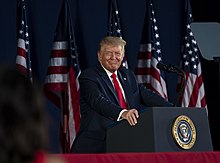|
National Garden of American Heroes
 A National Garden of American Heroes was proposed by President Donald Trump in executive orders on July 3, 2020, and January 18, 2021, as a sculpture garden honoring "great figures of America's history".[1] Trump first announced the idea at an Independence Day event at Mount Rushmore in Keystone, South Dakota.[2][3][4] The sculpture garden idea was part of a series of executive orders issued by Trump in his final months in office to address conservative cultural grievances; the second of the two executive orders was issued two days before Trump's term expired.[4] Congress never appropriated funding for such a garden,[5] nor were concrete steps ever taken to construct such a site.[4] President Joe Biden revoked the executive orders relating to the garden in May 2021.[4][6] Trump's vision for the garden included statues of notable Founding Fathers, activists, political figures, businesspeople, athletes, celebrities, and pop culture icons.[4][7][3][8][9] The premise of the proposal and the selection of statues to be erected was questioned by historians and scholars, who described it as random and scattershot.[10][11][12] Trump executive ordersTrump's order said that the proposed garden would be managed by the Task Force for Building and Rebuilding Monuments to American Heroes, which would allocate funding from the Interior Department to establish the site. Members of the task force would include chairs of the National Endowment for the Arts and National Endowment for the Humanities, the Administrator of General Services, the chair of the Advisory Council on Historic Preservation, and any additional "officers or employees of any executive department or agency" designated by the president.[13] Trump described the garden as a response to the practice of removing monuments and memorials to Confederate figures and others; many such monuments were removed or destroyed in 2020 as part of a response to the George Floyd protests.[2][13] In his Mount Rushmore speech announcing the proposal, Trump claimed that "Angry mobs are trying to tear down statues of our founders, deface our most sacred memorials and unleash a wave of violent crime in our cities" and pledged to build "a vast outdoor park that will feature the statues of the greatest Americans to ever live."[12] Under Trump's Executive Order 13934, issued July 3, 2020, the task force was granted 60 days to develop preliminary plans for the site, including a potential location,[14] and was to open before July 4, 2026, the 250th anniversary of the adoption of the Declaration of Independence.[13] The original executive order listed 31 historical figures as examples of those who would receive a statue in the Garden.[1] On January 18, 2021—two days before leaving office—Trump signed a new executive order (Executive Order 13978) listing 244 historical figures, including all 31 previously named, of those who would receive statues.[15][16][17][18][19] The revised list included 192 men and 52 women.[11] Reception by historiansHistorians questioned the scattershot nature of Trump's proposal; James R. Grossman, the executive director of the American Historical Association, said that "The choices vary from odd to probably inappropriate to provocative" and suggested that the proposal was an attempt by Trump "to seize on a cultural conflict to distract from other issues" during an election season, as suggested by the short (60-day) timetable that Trump set forth in his order.[12] Historian Karen Cox described the executive order about the proposed monument as "random" and said that "Nothing about this suggests it's thoughtful."[12] Historian Adam Domby noted Trump's initial list included no Native Americans, and included George Patton but omitted Dwight D. Eisenhower.[12] The premise of Trump's proposal was criticized by historian Michael Beschloss, who wrote that "No president of the United States or federal government has any business dictating to citizens who our historical heroes should be. This is not Stalin's Russia. Any American who loves democracy should make sure there is never some official, totalitarian-sounding 'National Garden of American Heroes,' with names forced upon us by the federal government."[11][20] Revocation of executive ordersThe garden was considered highly unlikely to be built, and Congress never appropriated any funds for the project.[5] On May 14, 2021, President Biden issued an executive order that revoked both of Trump's executive orders on the Garden, as well as various other Trump-issued executive orders.[4][6][21] Proposed statuesThe original executive order listed 31 historical figures as examples of those who would receive a statue in the Garden.[1] On January 18, 2021—two days before leaving office—Trump signed a new executive order listing 244 historical figures, including all 31 previously named, of those who would receive statues.[22][23][24][25] The revised list included 192 men and 52 women.[11] Names marked with an asterisk (*) were included in the original executive order.
See alsoReferences
|